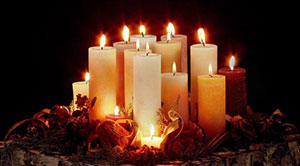Candles have been used for light and to decorate man’s celebrations for more than 5,000 years, yet little is known about their origin.
It is often said that the first candles were used by Ancient Egyptians, who used torches made by soaking the hard core of reeds in melted animal fat. However, the torches had no wick like a true candle.
Early wick candles were firstly used by the Egyptians in 3,000 B.C., on the other hand ancient Romans used wicked candle before that time by dipping rolled papyrus repeatedly in melted beeswax. The resulting candles were used to light homes, aid travelers at night, besides their usage in religious ceremonies.
Historians stressed that many other early civilizations developed wicked candles by using wax made from available plants and insects. It is said that the early Chinese candles have been molded in paper tubes, using rolled rice paper for the wick, and wax from an indigenous insect that was combined with seeds. In India, candle wax was made by boiling the fruit of the cinnamon tree. While in Japan, candles were made of wax that was extracted from nuts tree.
A major improvement came to light in Middle Ages, when beeswax candles were introduced in Europe. They scorched purely and cleanly, without producing a smoky flame, emitting a pleasant sweet smell. Beeswax candles were widely used for church ceremonies, but because they were expensive, few people could afford to burn them at home.
At that juncture, the growth of whaling industry in the late 18th century brought the first major change in candle making since Middle Ages, when spermaceti became available in quantity. It was harder than both tallow and beeswax, so it wouldn’t soften or bend in the summer heat. Historians stressed that first “standard candles” were made from spermaceti wax.
The key developments impacting contemporary candle making occurred during the 19th century when a new kind of wax was discovered by French chemist, Michel Eugene Chevreul . It was hard, durable and burned cleanly.
In 1834, inventor Joseph Morgan, developed a machine allowing nonstop production of molded candles. So by the introduction of mechanized production, candles became an easily reasonably priced commodity for masses. Yet, in 1879, candle making began to decline as a result of the introduction of the light bulb.
At the first half of the 20th century, candles enjoyed renewed popularity that remained steady until the mid-1980s, when interest in candles as decorative items and gifts began to increase notably. Candles were suddenly available in a broad array of sizes, shapes and colors. In the 1990s new types of candle waxes were being developed.
Today, candles symbolize celebration, mark romance, soothe senses, define ceremony, and accent home decors casting a warm and lovely glow for all to enjoy.
Amal Farhat

